How to ask ChatGPT for resume help
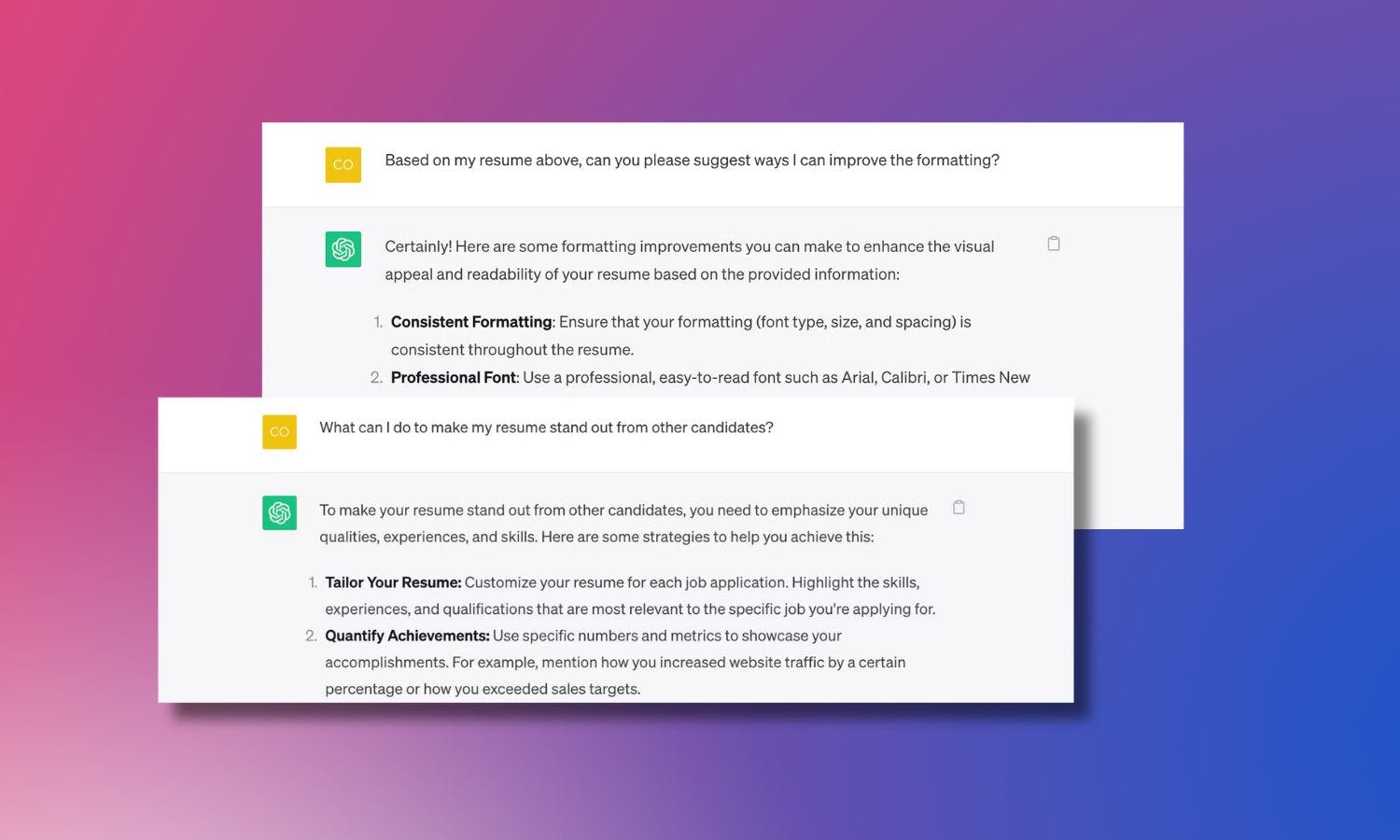
Share On
Whether you’re looking for your first job or you’ve been in the labor market for decades, grabbing and holding the attention of recruiters can be a challenge. But did you know that you can learn how to ask ChatGPT for resume help?
As generative AI tools become more accessible and the scope for how we can use them becomes wider and vaster, more and more people are turning to AI chatbots to help them write everything from poetry to code — and of course, their resume!
Not to mention, there's also a range of fantastic AI resume tools out there that focus on building a polished and professional profile to help you stand out from the crowd - check out HyreSnap, ResumeMaker.Online, KickResume, or ResumeAI, to name a few.
Below, I’m talking you through everything you need to know about using ChatGPT to craft the perfect resume, and if that whets your appetite for everything AI app related, check out these great ChatGPT plugins.
Should you use ChatGPT on your resume?
Yes, you can certainly use ChatGPT to help you write your resume. I’ve tested it out in-depth below and as you’ll see, it did a surprisingly good job at feeding back to me some very well-written and helpful text.
However, it’s important to note that whatever you get back from ChatGPT will not be personalized to the same depth and degree that it would be if you were writing it yourself. So I highly recommend using it as a solid starting point and then editing each paragraph to make it sound more ‘you’.
Some people are concerned about potential ethical issues with using ChatGPT to craft their resume, but I don’t see that being a problem at this stage as long as you use it to create a solid first draft that you then go on to enhance with your own personal flavor.
That being said, you may find yourself in a sticky situation if a potential future employer asks you directly whether you’ve used ChatGPT to craft your resume. That’s why it’s best to use it as a collaborative tool and not rely on it as the sole means of putting your resume together.
5 ways ChatGPT can help build or improve your resume
1. Improve the formatting and structure
There’s quite a skill to resume writing and unless you’re a writer by trade or a passionate wordsmith, you may not be familiar with how best to structure and format your resume to make it stand out.
Big blocks of texts that aren’t split into paragraphs or really long-winded sentences can be daunting to read and may cause your resume to be placed at the bottom of the pile.
But with ChatGPT, you can ask for suggestions on how to optimize the layout of your resume, tips on making it more user-friendly, and ways to construct your sentences and paragraphs to enhance readability.
Here’s an example of a prompt you can use:
“Please review my resume and make any suggestions for how I can improve the format and structure. I want it to be visually appealing, free of errors, and easy to read.”

Writer's screenshot
You can then pop your resume text into the question box and see what ChatGPT comes back with.
2. Identify your strengths
Let’s face it — most of us are great at identifying where we could improve, but we’re not always so good at listing our strengths. So, why not ask ChatGPT for help? Enter all of your experience and achievements and then ask ChatGPT to generate a SWOT analysis that you can use on your resume.
A SWOT analysis will give you a list of both your potential strengths and your potential weaknesses. The former will be great to use in your resume and cover letter and the latter may come in handy at the interview stage, where many employers are keen to identify whether a potential employee has the ability to self-reflect.
3. Enhance the content
Have you ever spent a ton of time writing something only to get to a certain point where you can no longer figure out how to word things in a more captivating way? This is a common issue that crops up when writing a resume, and it’s another place ChatGPT can come in handy.
Ask ChatGPT to refine the content. That could include re-wording your past employment history to give you more refined job descriptions, highlighting your accomplishments in a way that makes them stand out on the page, and helping you take mundane phrases and make them pop.
An example prompt you can use would be:
“Can you please review the section of my resume where I list my accomplishments and suggest ways that I can make these sound more impactful?”

Writer's screenshot
4. Identify and incorporate industry-specific keywords
If I was applying for a job as an SEO content writer, I’d want to incorporate particular phrases into my resume. I might mention things like SERP (Search Engine Results Page), CTR (click-through rate), backlinks, or E-E-A-T (Experience, Expertise, Authoritativeness, Trustworthiness) to show my knowledge of industry terms.
You can ask ChatGPT to identify industry-specific keywords that you can then insert into your resume. Many companies use applicant tracking systems to do the initial screening of candidates, so incorporating certain keywords will help your resume make it through that initial screening process.
5. Proofread and spot errors
Believe it or not, editing your own work is a lot harder than editing someone else’s. That’s because when you spend a lot of time with something, the mistakes get harder and harder to spot.
Depending on the industry you’re applying for a job in, one error in your resume could be enough to prevent you from being shortlisted. Attention to detail is important in a lot of fields, so asking ChatGPT to proofread your work can be a real lifesaver.
Here’s a prompt that you can try:
“Please proofread my resume and identify any mistakes with spelling, punctuation, grammar, or language usage and make suggestions on how I can improve these.”

Writer's screenshot
How to use ChatGPT to write a resume
1. Select a resume template
If you’re starting from scratch, the first thing you’re going to want to do is select a resume template. Google Docs, Microsoft Word, Adobe, and Canva are all great options if you want to create a resume that looks professional and polished.
2. Sign in to ChatGPT
Next, you’ll want to sign into ChatGPT or create an account. To do this, head to OpenAI’s ChatGPT homepage and follow the on-screen prompts. It’s quick, easy, and best of all, free, so you don’t need to enter any credit card details.
3. Introduce yourself
Provide as much information about yourself as you can to ChatGPT so that it can create a solid foundation for you. If you use too broad a prompt, you’ll end up getting a generic response back that you’ll spend a lot of time having to re-write, so include your name, education, previous work experience, and both your hard and soft skills.
Here’s an example of how you might provide ChatGPT with your education and work experience:
"Write a first draft of a resume using the following information:
Kathryn Rosenberg graduated from Victoria University of Wellington in 2004 with a Bachelor of Arts in history and political science. Kathryn also has a master's degree in social work from Massey University which she gained in 2013. Kathryn worked as a social worker from 2012 to 2014 at Totara Park Hospice and then from 2014 to 2020 she worked as an education facilitator at Dorothy House Hospice and was also an associate lecturer at the University of the West of England. From 2020 until today, Kathryn has been a freelance SEO content writer.”
As you can see from the images below, ChatGPT does an excellent job of providing me with a good starting point that I can now build on. It’s also come back and asked me a few questions that can help it further refine my resume information.
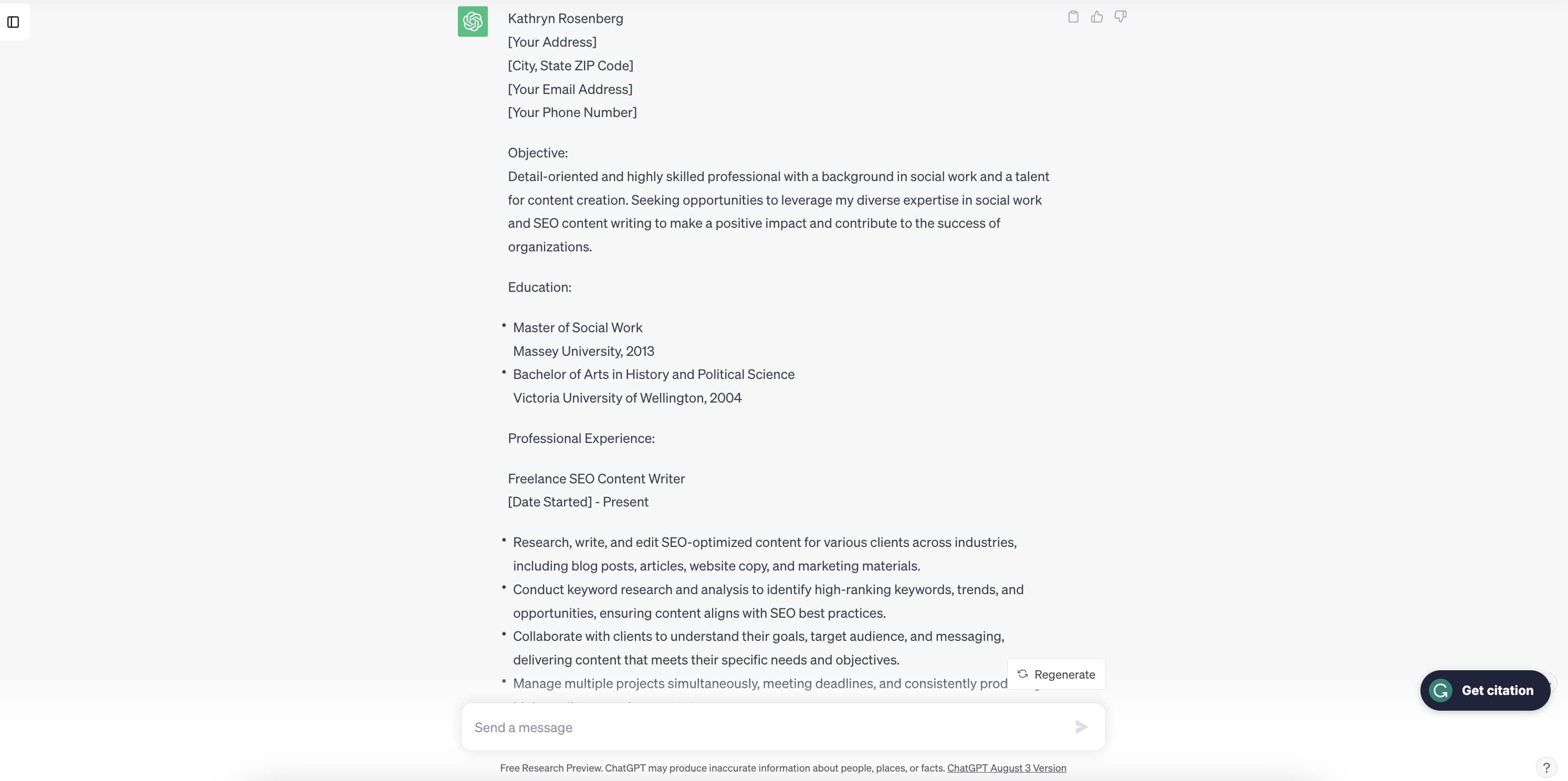
Writer's screenshot
4. Provide more details on your work experience
In my case, ChatGPT got fairly close to nailing my job description for my previous roles. However, there are various achievements that I would want to add in and a few refinements I’d want to make to polish things up and make my resume more personal.
You may also find that the information that comes back is either too generic or entirely inaccurate, so you may wish to ask ChatGPT to rewrite your resume bullet points based on a specific job description, which you can copy and paste into the question box.
5. Create your resume summary
While this isn’t compulsory, I’m a fan of having a little resume summary that sits under my name and job title. This provides any prospective client or employer with a quick overview of your skills and experience.
I gave ChatGPT the following prompt: ‘Can you write a short, professional resume summary about my role as a freelance writer’ and was pleasantly surprised with what it came back with!
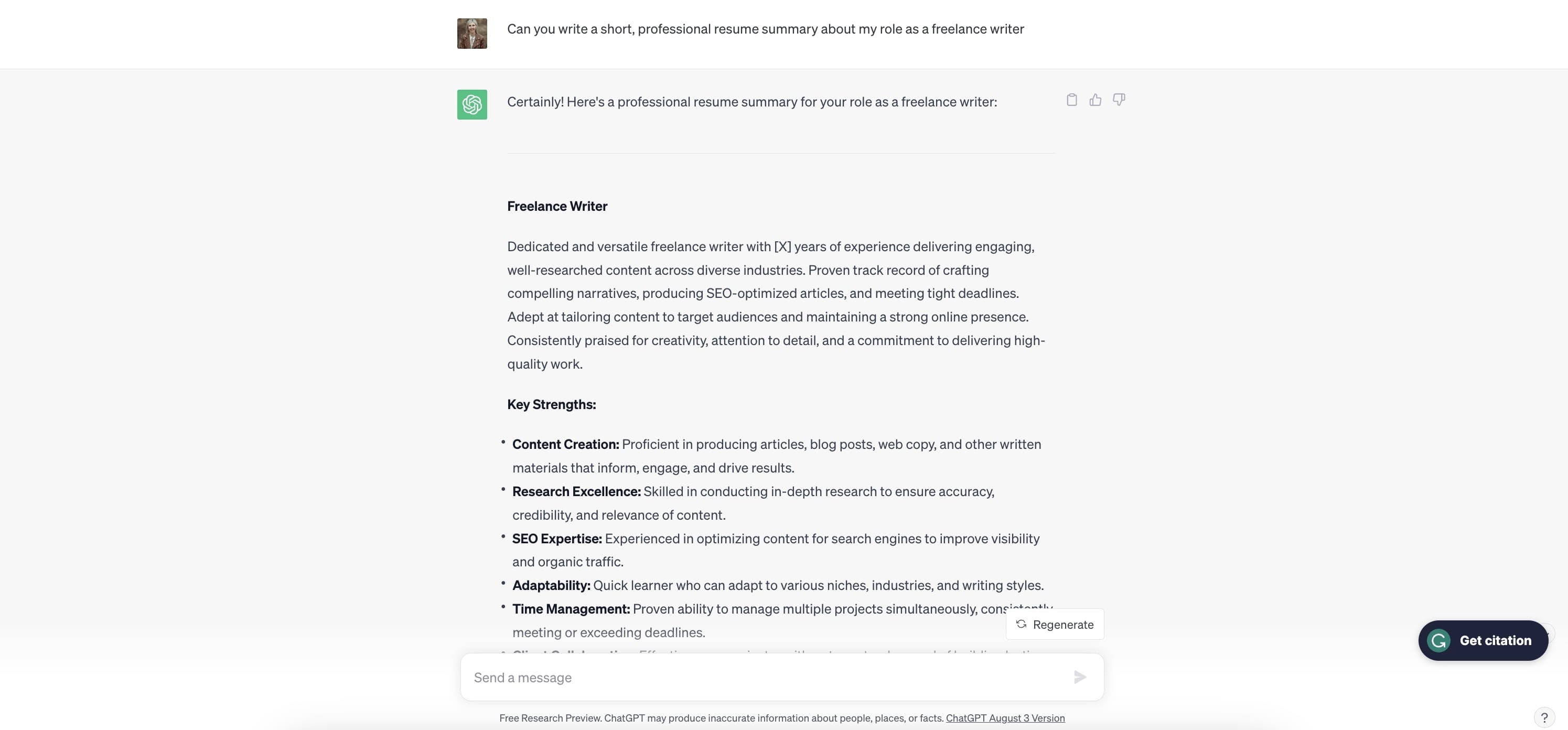
Writer's screenshot
Although this is a great starting point, I highly recommend you tweak the text that comes back to be personalized to your unique strengths.
For example, I then used the prompt: ‘Write a resume summary that showcases my skills in SEO content writing and also highlights my passion for writing and content creation.’

Writer's screenshot
Can you see how simply adding in the word ‘passion’ enhances the response I got from ChatGPT while also starting to infuse the words with more of my personality?
Keep refining your prompt until you get a summary that works for you.
How to ask ChatGPT to tailor or update a resume
If you already have a decent resume and simply want to update it or take it up a notch, ChatGPT can help you there too. When it comes to updating your resume, ChatGPT can help you with the following:
1. Editing your resume
As we discussed earlier, getting ChatGPT to proofread your resume to pick up on any errors is a great way to ensure it’s free from mistakes before you submit it. However, you can also ask ChatGPT for other editing assistance.
For example, you could use the following prompt: “Please read my resume and suggest any improvements or edits I could make.”

Writer's screenshot
2. Providing you with feedback that can help you make your resume more relevant, concise, and engaging
In a world that’s full of noise, clear and concise writing that holds your reader's attention is essential when it comes to standing out from the crowd. In order to make your resume pop, try a prompt like:
“How can I make my resume more succinct and compelling?” or, “How can I make my resume stand out from other candidates applying for this job?”
You might also try a prompt such as:
“Please tell me how I can improve the following sentence so that it sounds more engaging: Wrote a range of SEO content including short news pieces and long-form features across a wide range of topics, including health and wellbeing, parenting, pets, and productivity.”
As you can see, the response I got back took a sentence that sounded boring and flat and turned it into text that now sounds much more alive.

Writer's screenshot
3. Tailoring your resume for a specific job
Did you know that you have just six seconds to capture a recruiter's attention? According to an ex-Amazon recruiter, that’s how long you have to impress a potential future employer before they move on to the next resume.
With that in mind, you want to make sure that the information that they’re going to be scanning for jumps out at them quickly. To do this, make sure you have a copy of both your resume and the job description to hand, and then try the following prompts:
“Identify three ways I can improve my resume to match the job description I’ve provided above.”
“Please tailor my resume to this [JOB TITLE] at [COMPANY] using this job description.”
“Using my current resume supplied above, how can I rewrite it to apply for [JOB TITLE] at [COMPANY]?”
“Using my resume, please re-write my work experience so that it’s tailored for this [JOB TITLE] at [COMPANY].”

Writer's screenshot
4. Identifying common resume mistakes and weaknesses
Here are a few common resume mistakes that you want to avoid:
- Including a photo
- Listing every job you’ve ever had
- Making a lot of mistakes with spelling, punctuation, and grammar
- Using an unprofessional font
- Going over the top with the design
- Not using the proper formatting
- Making your resume too long or too short
- Focusing on your responsibilities instead of your accomplishments
You can use ChatGPT to help you steer clear of these by using prompts such as:
“Based on my resume above, can you please suggest ways I can improve the formatting?”
“Using my current resume, rewrite it to include achievements that match this job description.”
“Using my resume above, how can I structure and format it so that it looks visually impressive and professional?”
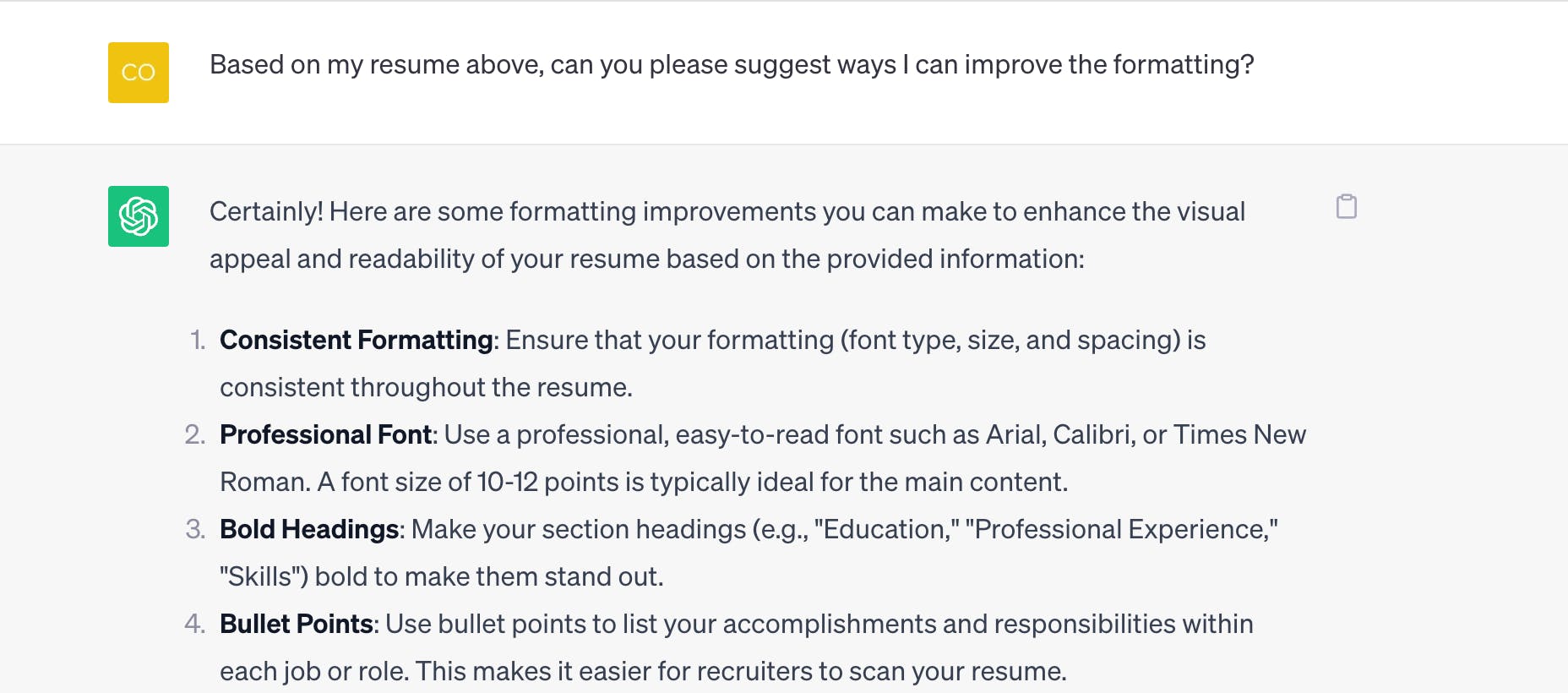
Writer's screenshot
5. Determining if certain work experience should be included in your resume
Does your resume read like a very long walk down memory lane? If you’re still including that customer service role you had at the grocery store when you were in high school, it’s time to give your resume a good dust down.
Try a prompt like:
“Please tailor my resume to include only the work experience that is relevant to this [JOB TITLE] at [COMPANY].”
Or you might prefer “Please omit any jobs from the resume above that aren’t relevant to this [JOB TITLE] at [COMPANY] or that I held more than 10 years ago.”
This will help your resume to be as concise and relevant as possible.

Writer's screenshot
15 best ChatGPT resume prompts
Alongside all of the prompts listed in this article, here are a few others that will help you create a resume that will get you noticed:
Use these ChatGPT prompts if you’re starting from scratch
1. Write a resume for a [TITLE] based on this job description (copy and paste the job description).
2. Write a resume based on this [JOB TITLE] at this [COMPANY].
3. Create bullet points for my most recent [JOB TITLE] that showcase my achievements and impact.
4. Generate bullet points highlighting my experience in [JOB FUNCTION/TASK.
5. Create bullet points that showcase my ability to [RELEVANT SOFT SKILL]
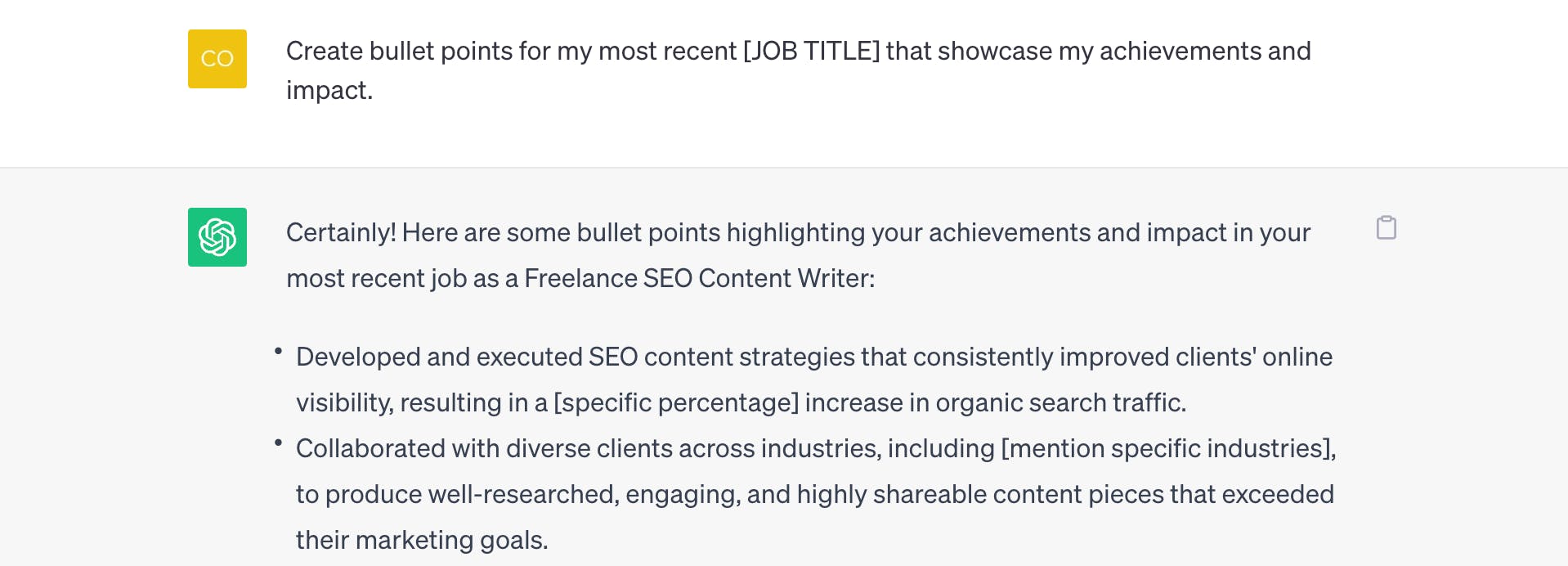
Writer's screenshot
Use these ChatGPT prompts to optimize an existing resume
1. Please review my resume above and suggest any improvements or edits
2. How can I make my resume more concise and to the point?
3. What can I do to make my resume stand out from other candidates?
4. Based on the job description above, what keywords should I include in my resume?
5. Can you suggest ways that I can tailor my resume to [JOB TITLE] at [COMPANY]

Writer's screenshot
Use these ChatGPT prompts when writing your summary section
1. Based on my resume, write a compelling professional summary of my experience and keep it under 100 words.
2. Generate a summary that highlights my unique strengths and will make me stand out from other candidates.
3. Create a summary that conveys my passion for [INDUSTRY] and my future career aspirations.
4. Write a summary that showcases my ability to [SKILL]
5. Create a professional summary under 200 words that highlights my experience relevant to [JOB TITLE] in [INDUSTRY].
Comments (7)
Alan Frost@alan_frost
Creating a professional resume is of utmost importance in today's competitive job market. It's your first impression on potential employers, and a well-crafted resume can significantly increase your chances of landing your dream job. While there are many online services available, including some affordable options like a cheap CV writing service, leveraging AI tools like ChatGPT can be a cost-effective way to enhance your resume.
AI chatbots, like ChatGPT, offer several benefits when seeking resume help. They can assist in formatting, structure, content refinement, and identifying industry-specific keywords to optimize your resume's effectiveness. Moreover, they can help you proofread and spot errors that may otherwise go unnoticed, ensuring a polished and error-free document.
However, it's essential to remember that while ChatGPT can be a valuable resource, it should be used as a starting point and not as the sole means of creating your resume. Personalization is key to making your resume truly stand out, and human input is vital in achieving this. Therefore, consider ChatGPT as a collaborative tool to complement your resume-building process.
Share
@alan_frost It's also possible that the data you receive is completely erroneous or overly general.
retaining wall services
This is a big help for www.delawaredrywallers.com
Thank you so much!
🚀 A beacon of innovation.
I find knowing how to use ChatGPT would be an advantage. - a small world cup
More stories

Sanjana Friedman · Opinions · 9 min read
The Case for Supabase

Vaibhav Gupta · Opinions · 10 min read
3.5 Years, 12 Hard Pivots, Still Not Dead
Kyle Corbitt · How To · 5 min read
A Founder’s Guide to AI Fine-Tuning

Chris Bakke · How To · 6 min read
A Better Way to Get Your First 10 B2B Customers


